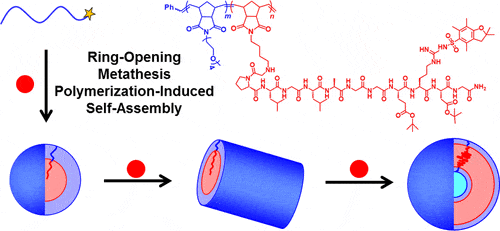With extensive professional knowledge in polymer synthesis, characterization, isolation, purification, and bioconjugation, BOC Sciences is dedicated to serving our clients' unique needs in polymer development projects by providing customized services tailored to satisfy your R&D timeline and budget. We also have first-class experimental equipment and provide professional analysis and development services.
Ring-opening metathesis polymerization (ROMP) is a chain-growth polymerization process. ROMP reaction uses strained cyclic olefins to produce stereoregular and monodisperse polymers and copolymers. The polymerization mechanism is based on olefin metathesis, a unique metal-mediated carbon-carbon double bond exchange process. ROMP converts cyclic olefins into linear polymers containing olefins in the main chain, and any unsaturated monomers are converted to polymers. ROMP can provide a wide range of polymers with unique architectures and valuable functions. The initiation step involves the coordination of the cyclic olefin to metal alkylidene complex, and subsequently, [2+2] cycloaddition produces a metallacyclobutane intermediate to form the growing polymer chain. This intermediate undergoes cycloreversion to afford a new metal alkylidene. Analogous steps are repeated during propagation stages until polymerization ceases. That is, the monomer is completely consumed when the reaction reaches equilibrium or termination.
 Fig. 1. Ring-opening metathesis polymerization-induced self-assembly (ACS Macro Lett. 2017, 6(9): 925-929).
Fig. 1. Ring-opening metathesis polymerization-induced self-assembly (ACS Macro Lett. 2017, 6(9): 925-929).
Ring-opening metathesis polymerization (ROMP) is commonly quenched by the addition of ethyl vinyl ether, which reacts with metal carbene species of a growing polymer chain's terminus, then metal carbene is removed from the polymer. In addition, the omitting-related procedure leads to degradation of the product polymer and causes metal residue contamination in the isolated material. In ROMP, the most common monomers used are cyclic olefins and reserved considerable ring strain, such as cyclobutene, cyclopentene, cis-cyclooctene, and norbornene. ROMP is commonly accompanied by intermolecular and intramolecular chain-transfer reactions. During intermolecular chain transfer, a polymer chain having the active metal alkylidene on its terminus reacts with the double bond in another polymer chain. Then, individual polymer chains increase or decrease in molecular weight accordingly, resulting in the total number of polymer chains being unchanged. During intramolecular chain-transfer reaction (backbiting), the carbene terminus of a polymer chain reacts with itself to form a polymer chain with reduced molecular weight and release a cyclic oligomer. Both intermolecular and intramolecular chain transfers increase the polydispersity of the polymer product.

BOC Sciences is committed to the development of cutting-edge polymer synthesis technology. We have established a full technology development service, including the mature polymer development process, purification process, determination of quality standards and critical process parameters, as well as subsequent formulation development of products. Ring-opening metathesis polymerization (ROMP) has evolved into one of the most prevalent technologies for making functional polymeric materials in academia and industry. Furthermore, ROMP is widely considered an excellent living polymerization technique that proceeds rapidly under ambient conditions and is highly functional and tolerant when performed in organic solvents. BOC Sciences offers a comprehensive variety of ROMP-catalyzed reactions, including heterogeneous catalysis reactions for large-scale commercial synthesis and homogeneous catalysis reactions for fine chemical synthesis. Our ROMP polymerization has emerged as a powerful and broadly applicable method for synthesizing macromolecular materials.

References